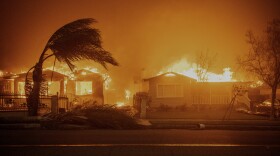SCOTT SIMON, host:
Friday marked the 20th anniversary of what became known as the 8-8-88 student uprising in the country that we now call Myanmar. Back then everyone called it Burma. On August 8, 1988, hundreds of thousands of students and other demonstrators marched peacefully through Rangoon and in cities across the country to demand democracy and an end to military rule. But soldiers fired into the crowds. More than a thousand people were killed. Protests continued.
On September 18th, the military suspended the constitution and suppressed the public demonstrations with even more brutal force. Thousands more were killed and many members of the '88 generation, as they came to be called, were arrested, went into hiding or fled the country.
Doctor Thaung Htun was one of the leaders of the uprising in his township. He fled Burma in 1988 and he's since become the representative for United Nations Affairs for The National Coalition Government of the Union of Burma, essentially Burma's government-in-exile. Dr. Htun joins us from our studios in New York. Doctor, thank you so much for being with us.
Dr. THAUNG HTUN (Representative, United Nations Affairs for The National Coalition Government of the Union of Burma?): Yeah, that's my pleasure.
SIMON: What happened on August 8, 1988?
Dr. HTUN: Yeah. It's a terrible, terrible experience. On that day, together with a group of students, I went around the city with loudspeaker, mobilizing the public to join at that rally. And soldiers came in and tried to interrupt our announcement. They arrested us for a while at a government building. But within a few minutes, you know, many people surrounded the building and demanded for the release of us. So fortunately we were released back.
SIMON: Yeah. And what were you hearing about the demonstrations in Rangoon at that point?
Dr. HTUN: You know, it's a big demonstrations and on 18 September the regime used force to crack down the demonstration. They shooted into the crowds and you know, minimum at least, you know, that 3,000 people were killed in the streets. The crackdown in our hometown have been treaties, Alia(ph) then that crackdown in Rangoon. And the early morning of 17, you know, that soldiers raided the headquarters of the strike committee which was located in a Magoder(ph) in our hometown. And then they fire their can, you know, in the dark. But fortunately, you know, some of the students brought me out from the Magoder. They put me into a dry shore and drove to a village which was three hours drive from our hometown.
SIMON: Can you bring us back to help us understand why you thought it was important to go into the streets?
Dr. HTUN: Yes. You know, as a young medical doctor, I started to realize that a country like Burma, which was known as the "rice bowl of Asia," I started to see their problem of malnutrition, especially among the children. Because the government spend just a little bit of money for the health and social welfare and spend more than 40 percent of the budget in the military, so I started to feel that we have to change the system.
SIMON: The demonstrations, which you helped organized and lead, occurred 20 years ago. Twenty years later, an entire generation of Burmese has grown up under the regime that you were trying to displace. Does that raise the question as to what your demonstrations accomplished?
Dr. HTUN: Yeah. Of course, you know that 8-8-88 demonstration, at least instill the inspiration for democratic struggle. You know, last year when public protest led by the Buddhist monks happened, I informed young generation joining in the movement. It is the very encouraging sign.
SIMON: Doctor, thank you so much.
Dr. HTUN: Yeah. That's my pleasure.
SIMON: Dr. Thaung Htun was a protest leader in the 8-8-88 demonstrations all over Burma, speaking to us from New York. Transcript provided by NPR, Copyright NPR.






